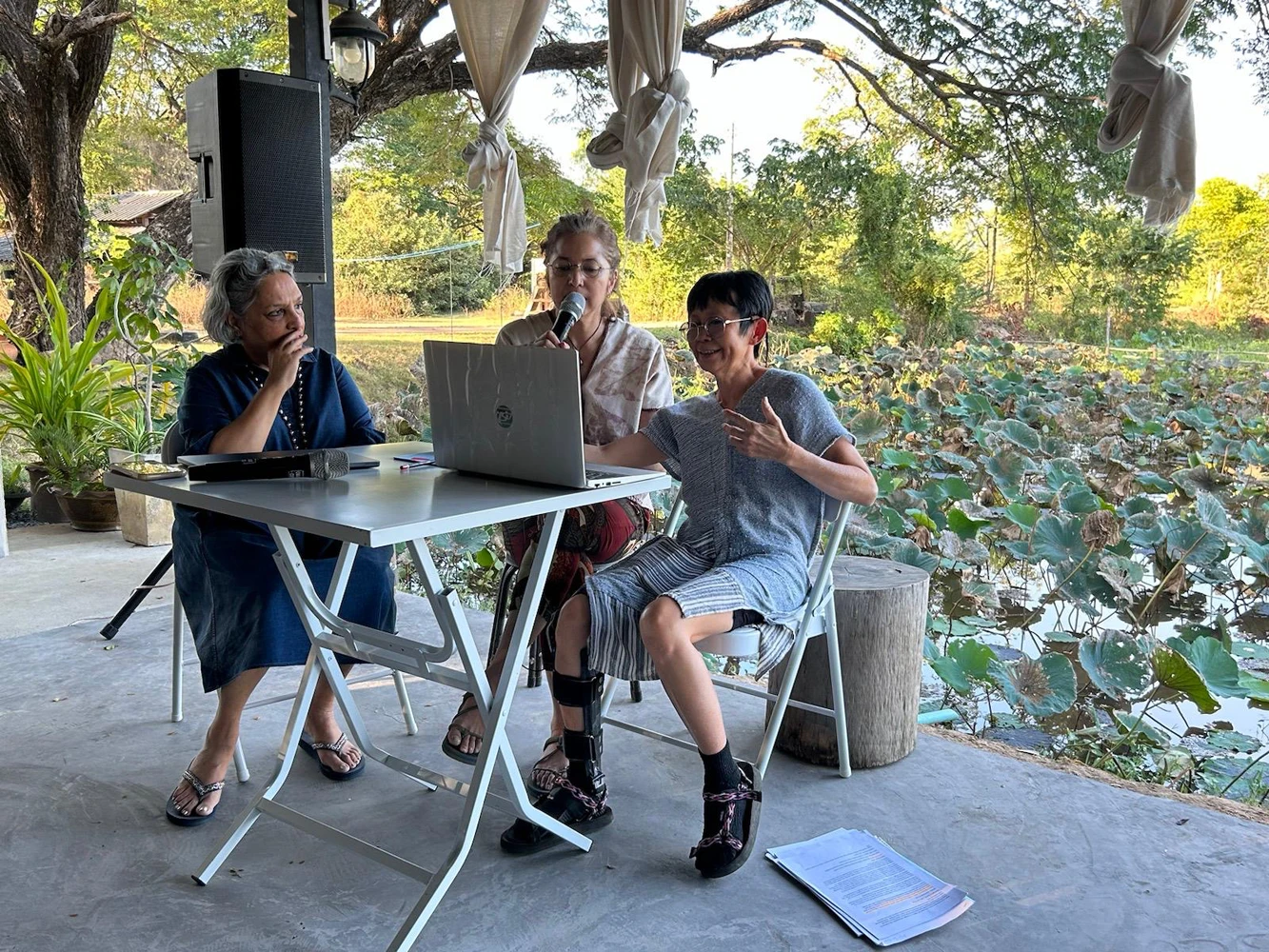Editorial Collective
i) On Womanifesto

Womanifesto is a women-centred arts collective that began in Thailand in 1995. Three decades of inclusive projects and creative reinventions have seen Womanifesto work with more than 150 collaborators from 45 countries.
The ethos of this diverse and dispersed group of artists, sometimes called the Womanifesto way, celebrates hospitality, communal activity and togetherness, focusing on the position of women and the wealth of women’s knowledge. Womanifesto aims to strengthen connections between artists internationally and engage local communities while promoting new and emerging forms of artistic expression.
Through exhibitions, workshops, artists’ residencies, and other in-person and online programs, Womanifesto links practitioners from Thailand with regional and international artists, highlighting shared cultures and establishing fresh exchanges. Many voices, and many ways of making and knowing are cherished and championed.
ii) Towards a Womanifesto Way

This publication aims to share and reflect the Womanifesto way. It intends to document and discuss Womanifesto’s past activities, while also suggesting possibilities for ongoing and future creative collaborations.
Consistent with Womanifesto’s ethos of inclusiveness and hospitality, this publication features a wide variety of contributions, far exceeding those found in a typical monograph or scholarly volume. Conventional, scholarly essays appear alongside more experimental and unconventional texts and conversations, as well as images, and audiovisual contributions. English, Thai, and other languages commingle.
As the subject of a publication, Womanifesto demands to be represented through the relationships they form, their invisible labour, the meals they share and the casual conversations that eventually materialise as an activity or event. This demand extends to the way in which they view their history: not as fixed events, indexed by documents and recordings, but as part of an ongoing and ever-expanding network.
The Womanifesto Way is therefore faced with two seemingly opposite demands: indexing the past and articulating future possibilities. In responding to these prompts, this digital project consists of two components—elements of the Womanifesto Archive and the Womanifesto Way Anthology itself—which interact through the website’s interface. This reading experience represents Womanifesto’s relational network as it spans disciplines, generations, events and exhibitions.
iii) A multimodal anthology

This publication represents a unique experiment in collaborative digital publishing. Rather than following traditional academic models, the editorial collective has worked together to create content that emerges from and serves the Womanifesto community itself. The process has been as important as the outcome—workshops, conversations, and collaborative exchanges have shaped not only what stories are told, but how they are presented. This approach ensures that the many voices within Womanifesto's network are not just represented but actively involved in shaping their own histories and narratives.
The creation of this anthology also reflects Womanifesto's remarkable ability to adapt and evolve. From the original biennial exhibitions in Bangkok and farm-based workshops, to digital collaborations in the early 2000s and during more recent global disruptions, Womanifesto has consistently found new ways to maintain meaningful connections across distances and differences. This publication continues that tradition of creative adaptation, using digital tools not simply to display archival materials, but to reveal them among their networks of relations, creating new possibilities for encounter, reflection, and ongoing collaboration. The Womanifesto Way stands as both a documentation of past achievements and a platform for future creative exchanges.
iv) A networked history
In this publication, personal and critical reflections on Womanifesto’s activities are shared alongside curated links to Womanifesto’s archive of hundreds of materials, digitised by Asia Art Archive. Our intention here is to enable readers and users of this publication to plot their own paths through the many stories shared here, discovering the threads between the people (‘makers’), their projects (‘makings’), and the formation of their histories (‘musings’), drawing their own conclusions about the strengths and limitations, significance and possibilities—past and future—of Womanifesto.
____________________________________
Find your own way
To facilitate exploration of this rich material, this publication presents a network of content that can be navigated in several ways:
- A nodal interface allows you to interact with the Womanifesto network as a whole. Each point on this node map corresponds to a different maker, making or musing,, the related page presenting information and materials, as well links to related nodes.
- A facet and filter panel enables you to create subsets of nodes by content types as well as other categories such as media types, languages, dates, and tags.
- Four categorised lists present this same information not as a network, but as a set of pages, organised into the categories 'makers', 'makings', 'musings' and 'materials'.
- A selection of the material presented digitally in this publication will also be made available as printable and saveable PDFs.
See How to explore this project for guidance, including recommended pathways and views.
____________________________________
Add your contribution
You can add your voice to this project in two ways. We invite people with a connection to or a memory of Womanifesto to add reflections on pages. Every page has a comment box where you can add a reflection.
We are also inviting people to help us fill out the biographies of the many artists and other contributors who have been part of Womanifesto events, projects and exhibitions over the decades. You can view the list of 'Makers' here, and if you see someone is missing, or a biography without much information please tell us what we can add using this google form: https://forms.gle/KNvbBUUCnDP9iL899
If you would like to send us other images or files, or let us know something else. Please use this form: https://forms.gle/XxTPhP2ekhwttx7S9
____________________________________
A collective production
This publication has been produced by an editorial collective comprising the founding members of Womanifesto as well as several other collaborators, listed below:
Editorial Collective: Dr Yvonne Low, Varsha Nair, Dr Roger Nelson, Phaptawan Suwannakudt, Nitaya Ueareeworakul and Marni Williams.
Power Digital Publications Team: Lachlan Thompson, Dr Katrina Grant, Marni Williams.
Website development: Isobel Andrews, Yang Li, Ian McCrabb, and Mufeng Niu of Systemik Solutions.